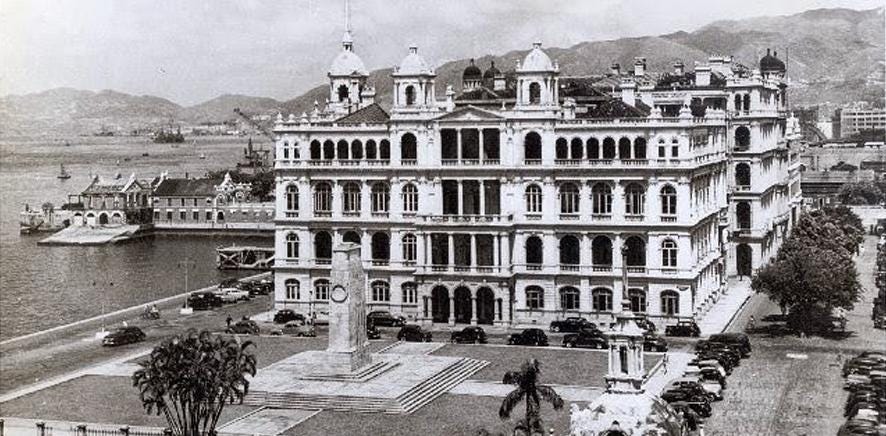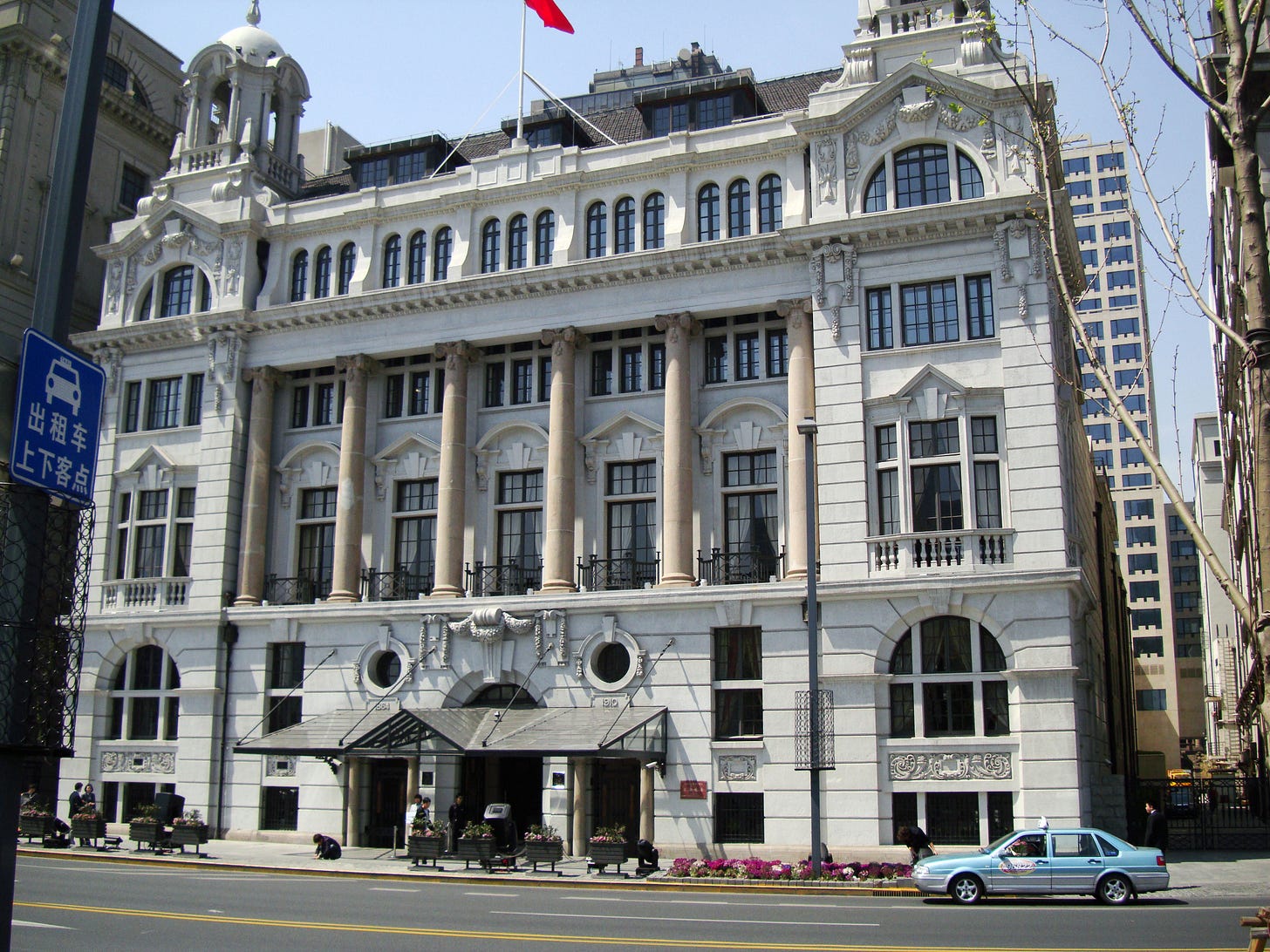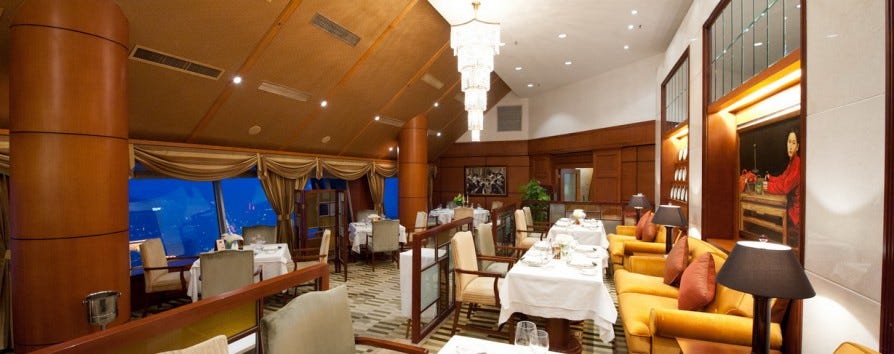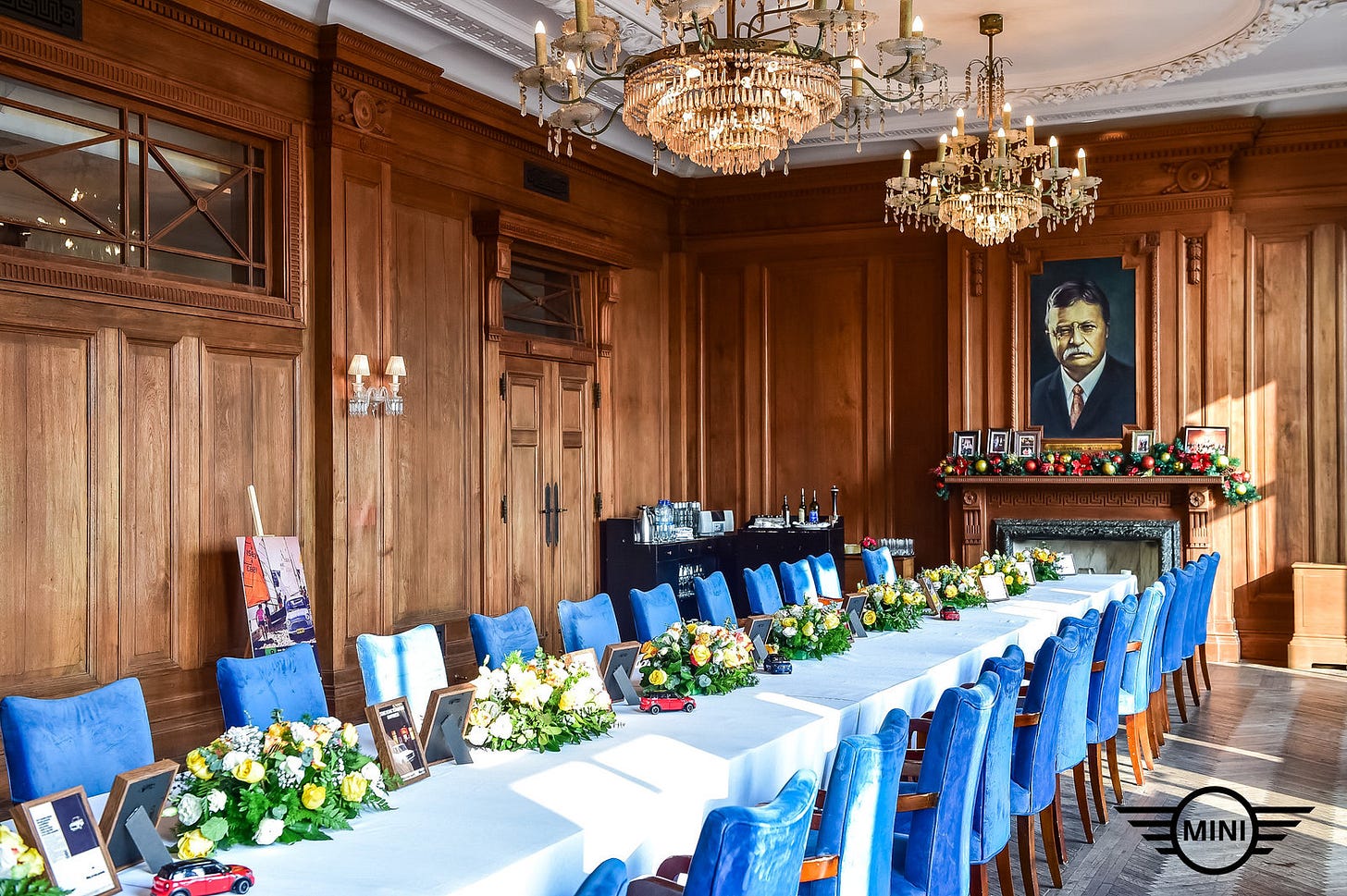Despite being the second-most populous country on earth, with the third-largest landmass, China’s club tradition has been limited for most of its history to the former colonies of Hong Kong and Macao, and the pre-1941 international settlement in Shanghai.
Since the market reforms of the 1990s, however, a small number of luxury clubs in and around the major cities have catered to the country’s super-wealthy - with mixed results, including some being closed down on corruption charges.
The early British influence in Hong Kong
The earliest clubs in China were British imperial exports to Hong Kong island – with the first being the Hong Kong Club in 1846, which provided facilities for senior soldiers and civil servants, and was in the mould of other existing clubs in imperial port cities such as Bombay, Calcutta, Madras and Melbourne.
The Hong Kong Club’s second clubhouse, from 1897-1981. It was demolished to make way for the current skyscraper. (Photo credit: Hong Kong Club website.)
Hong Kong also emulated the British predilection for running sports and athletics clubs along the lines of a private members’ club - as seen with the Marylebone Cricket Club established in 1787 on the outskirts of London’s then-boundaries. The British brought that model to Hong Kong, as reflected in clubs like the Hong Kong Cricket Club (founded in 1851), the Hong Kong Football Club (1886) and the Hong Kong Golf Club (1889). Each remains more than just a sports club, with a clubhouse serving extensive social functions.
The grounds of the Hong Kong Cricket Club. (Photo credit: Hong Kong Living.)
Meanwhile, Hong Kong built up a profusion of city clubs - there are still several dozen today, old and new, with some of the more notable historic ones including the Helena May Club (1916), originally founded as a ladies’ club, though in practice mixed-sex today, and ever-popular with reciprocals abroad for being the only historic Hong Kong club to offer bedroom accommodation; and the Foreign Correspondents’ Club (1943), one of the world’s premiere press clubs, noted for the quality of gossip at its bar.
The Helena May Club’s 1916 Edwardian classical revival-style clubhouse in Hong Kong. (Photo credit: Helena May Club website.)
Portuguese club culture in Macao (1870-1999)
With the Portuguese presence after 1557 in the Macao peninsula, some 40 miles west of Hong Kong, came the arrival of Portuguese club culture. Portugal itself has clubs dating back to the late 18th century. While their empire was much diminished by the 19th century heyday of Clubland, Portuguese military and naval clubs were exported to strategic ports in colonies such as Angola, Goa and Mozambique, typically catering to either officers or their wives. The Clube Militar de Macao was founded in 1870 along these lines.
The Clube Militare de Macao building. (Photo credit: TripAdvisor.)
The Club eventually closed down in the early 1990s, before reopening in 1995 with the ground-floor dining room becoming a public-facing restaurant, but retaining members’ rooms in the rest of the historic clubhouse - and it remains open on this business model today.
Clubs in the Shanghai International Settlement (1861-1941)
On mainland China, the earliest clubs were in Shanghai, in the International Settlement. The most socially prestigious of these, the Shanghai Club, launched in 1861. After half a century, it had outgrown its original premises and in 1911, the Club moved into a grand new building that housed a range of other Shanghai clubs within it.
These all closed down with the Japanese invasion in 1941, and the seizure of the building by the Japanese authorities for the remainder of the occupation. The building still stands today.
The old Shanghai Club building, pictured today. (Photo credit: Matthew Laird Acred.)
The late 20th century
For the next fifty years, outside of the British and Portuguese colonies, clubs on mainland China remained dormant. The Japanese occupation and the subsequent Chinese civil war were scarcely conducive to setting up new clubs, while the idea of a private members’ club seemed anathema to the rule of Mao Zedong and Deng Xiaoping.
Hong Kong continued to have a booming club culture under British rule; with most of its clubs continuing after the handover to Chinese rule in 1997.
The late Barry Humphries was a keen club member (the Beefsteak Club, Garrick Club and Pratt’s in London; the Melbourne Savage Club in Australia; plus the Roxburghe Club for bibliophiles). For his risqué 1997 mockumentary The Great Chinese Takeaway, he visited the Foreign Correspondents’ Club of Hong Kong ahead of the Hong Kong handover, in character as boozy diplomat Sir Les Patterson.
Handover of Hong Kong and Macao
The handover of Hong Kong in 1997 and Macao in 1999 proved a watershed: while agreements like the 1984 Sino-British Joint Declaration should have theoretically ensured that little changed in administrative policies for the ensuing 50 years, such obligations have gradually been flouted by the Chinese authorities with increasing vigour, and are now treated as no longer binding. Abandonment of the “One country, two systems” model, increasing censorship and repression, and crackdowns against popular protests such as those seen in Hong Kong in 2019-20, have all taken their toll. Clubs which have tended to attract members quietly critical of the Chinese regime - but which are avowedly not political organisations - have faced a difficult operating environment. Nonetheless, as a major international financial centre, Hong Kong continues to see new clubs open up, and the historic clubs remain. But the climate in recent years has not been easy for members or staff.
Hong Kong today continues to host dozens of private members’ clubs.
The 1990s market reforms - and business clubs
Meanwhile, on the mainland, the traditional reticence of the Chinese Communist Party to sanction private members’ clubs softened considerably amidst the wave of market reforms in the 1990s.
Beijing’s Capital Club with its 50th floor views from the top of a tower. It has been a joint venture between a US company and the Chinese state, and was the first business club on the Chinese mainland. (Photo credit: Capital Club website.)
Beijing saw the first of a new wave of business clubs, with the Capital Club opening atop a skyscraper in 1994, operated as a joint venture between the US chain ClubCorp (since renamed Invited Clubs) and the state-owned China International Trust Investment Company. This was followed by the Chang An Club across four floors of the Beijing Tower building, launched in 1996. Meanwhile, Shanghai’s first modern business club, the Ambassy Club, opened in 1997, split between a downtown clubhouse and a second facility in the suburb of Pudong; followed by a Beijing branch which opened in 2006, before being shut down in the 2010s. These clubs all borrowed from the leisure roots of the Hong Kong clubs, and embedded sporting and athletics facilities in their clubhouses – a model later followed by more extensive ventures such as the Shanghai Racquet Club since 2000, the Beijing Riviera Country Club from 2010, and the Shanghai Town and Country Club from 2013-8.
The Beijing Riviera Country Club operates a vast facility. (Photo credit: Beijing Riviera Country Club website.)
Rather more modest is the Shanghai Savage Club, which opened in 2007. This states that it is “a branch” of the Savage Club in London, and operates as a weekly luncheon club. While the original Savage Club of London has six membership categories (Art, Music, Drama, Literature, Science and the Law), its Shanghai namesake has categories that are less contentious for the Chinese authorities (“Arts, Knowledge, Justice, and Discovery”).
2010s anti-corruption crackdown on city clubs
At the 18th National Congress of the Chinese Communist Party in 2012, Xi Jinping announced a major anti-corruption drive. Sceptics have accused the drive of itself being corrupt, often being aimed at the selective removal of political adversaries. One of the outcomes of the drive was the forced closure from 2014 onwards of whole swathes of urban venues identified with wealthy Chinese elites. These included high-end nightclubs, bars, restaurants - and private members’ clubs. The BBC reported in 2014:
“Each of the two dozen high-end clubs that have sprung up in the Chinese capital's public parks have been ordered to close or ‘downgrade to an acceptable level’, official news agency Xinhua reports. They must also leave the parks once their leases expire.
“In one club, Yushantang, in Beihai Park, a single dish can cost more than $1,600 - two months' salary for the average local worker - Xinhua reported. ‘The meals there are meant for officials and the wealthy, not for us,’ one Beijing resident exercising in front of the club told the agency.
“According to the state-run People's Daily newspaper, government officials found to have frequented the clubs will be severely punished. The Communist Party now requires all officials in Beijing to sign an agreement promising not to enter or join them.
“South China Morning Post, a Hong Kong-based paper, also reported public anger that some clubs were located in historic buildings. Examples include the Yushantang Club [also known as the Imperial Court Club], which is housed in a 270-year-old structure, and a hall in Beijing's ancient Forbidden City, which was converted into a luxury members-only club [and was closed down].”
The focus of the anti-corruption drive was around venues located in central business districts of major cities, including the Manet Club in Beijing, and the Kee Club in Shanghai.
Accordingly, several conspicuously luxurious country clubs in the suburbs noticeably escaped attention, such as the Beijing Riviera Country Club and the Shanghai Racquet Club - though the Shanghai Town and Country Club was closed down during the crackdown.
Furthermore, some major modern business clubs in the CBDs survived the cull. For instance, the Ambassy Club in Shanghai still exists but lowered its profile during this era, removing its public website and complying with the government order to “downgrade” its offering, including limiting its online presence to the state-approved app WeChat.
Chinese clubs after the anti-corruption drive
Despite the ostensible aims of the 2010s anti-corruption drive, this has not prevented the successful launch of several new clubs openly aimed at catering to a select number of the country’s super-wealthy.
Teddy Roosevelt looks down over the boardroom of the Roosevelt Club in Shanghai, formerly the boardroom of the Jardine Matheson headquarters. (Photo credit: House of Roosevelt website.)
Examples include the 2013-launched Roosevelt Club, a members-only floor in 1920s neo-classical Shanghai building The House of Roosevelt, which is the former Jardine Matheson headquarters, now carved up between luxury businesses across its floors. Its 200 members pay the equivalent of $25,000 a year, with its decor featuring somewhat incongruous oil paintings of former US Presidents Teddy Roosevelt and Franklin D. Roosevelt, and its logo being the Roosevelt family crest.
The Cha House in Shanghai, hosting The Residence, operated by Harrods. (Picture credit: Robb Report.)
A decade later, Shanghai saw the 2023 launch of The Residence in the city’s 1920-built Cha House. Harrods had already been operating the Cha House as a shopping suite for the super-wealthy of Shanghai, before converting part of the building into their first overseas private members’ club, embedding Gordon Ramsay’s first restaurant in China. Membership is limited to 250, and annual subscriptions start at the equivalent of $20,000.
Conclusion
Mainland China has not traditionally been “Club country.” It would be unusual if it had been, given the ostensibly Communist regime of the last eight decades. However, British, Portuguese and American clubs thrived in their respective 19th century enclaves of Hong Kong, Goa and the Shanghai International Settlement, meaning there has been some history of clubs here; and Hong Kong remains a major international centre of clubs - even if the current regime can make operations extremely challenging.
Since the 1990s, a new wave of business clubs aimed at the country’s super-wealthy elite has taken hold, but this has had a complicated relationship with a government which (officially, at least) disapproves of displays of conspicuous consumption.
You can view the full and varied backlog of Clubland Substack articles, by clicking on the index below.
Index
Articles are centred around several distinct strands, so the below contains links to the main pieces, sorted by theme.













